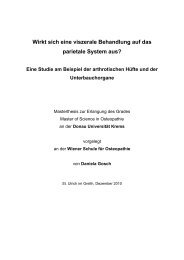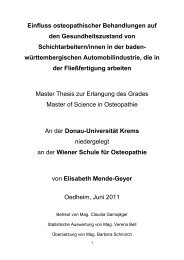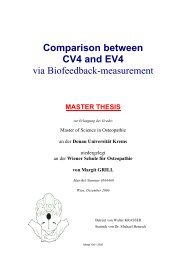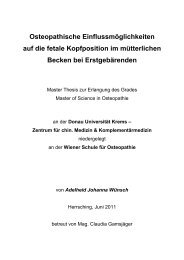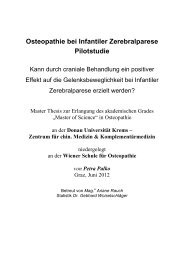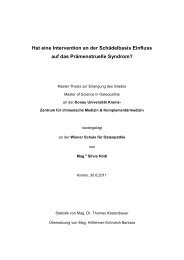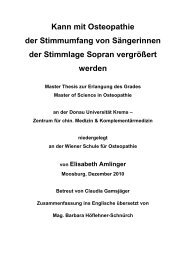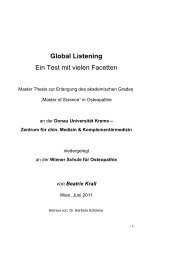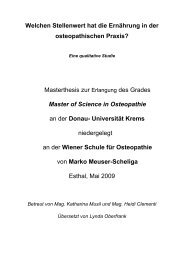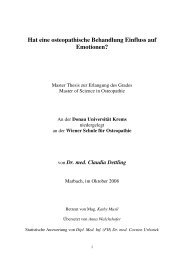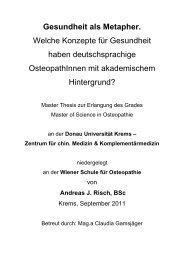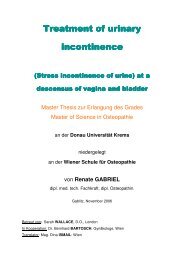2 Der viszeral assoziierte Schulterschmerz - Osteopathic Research
2 Der viszeral assoziierte Schulterschmerz - Osteopathic Research
2 Der viszeral assoziierte Schulterschmerz - Osteopathic Research
Erfolgreiche ePaper selbst erstellen
Machen Sie aus Ihren PDF Publikationen ein blätterbares Flipbook mit unserer einzigartigen Google optimierten e-Paper Software.
Viscerally Associated Shoulder Pain<br />
Subjective Perspectives and Diagnostic Procedures – the <strong>Osteopathic</strong> Point of View<br />
enterotome. The neural tube, which also establishes a segmental relationship with<br />
the mesodermal myotome and sclerotome, is part of the metameric differentiation<br />
process. Although individual parts of a segment are displaced during the<br />
embryological development process, they remain related throughout life by the same<br />
spinal nerve. This explains the interrelationship between the surface and the inside of<br />
the body and helps us to understand how disease may spread from an organ to the<br />
skin, the muscles or the bones within the corresponding segments (cf. Wancura-<br />
Kampik 2010).<br />
The second model that explains referred pain is based on the convergence of<br />
somatic and visceral afferents. It is thought that afferent neurons from the skin and<br />
visceral afferents from the organs converge via the dorsal root of the spinal cord to<br />
the same transmitting neurons (cf. Trepel 2008; Speckmann et al. 2008;<br />
Giamberardino 2003). Since the viscero-afferent and somato-afferent impulses blend,<br />
it is impossible to precisely allocate the origin of the pain and its perception.<br />
Consequently, the input from visceral fibres is interpreted as coming from the somatic<br />
tissue (cf. Trepel 2008; Schünke et al. 2006). This fact has a considerable impact on<br />
pain sensation since on the one hand, the brain does not seem to be capable, in<br />
certain cases, to localize precisely the origin of the disease and on the other,<br />
misinterpretations may occur. A pain may be triggered by a visceral organ, but the<br />
nociceptive system refers the pain to the shoulder-arm area, an extremity or the<br />
abdominal wall (cf. Egle et al. 1999, Speckmann et al. 2008). For example, spinovisceral<br />
afferents of the heart excite the coronary vessels when the vascularisation is<br />
reduced, e.g. in the case of ischemia of the myocardium, these afferents reaching the<br />
upper thoracic segments of the spinal cord. Somatic afferents from the left shoulderarm<br />
area end in the same segment. “The convergence of spinal neurons makes the<br />
information transferred to the CNS less precise, the stimulation of the cardiac<br />
afferents being referred to the shoulder-arm region as pain” (Speckmann et al.<br />
2008:73).<br />
Referred pain triggered by direct pressure represents the third model. A very<br />
important nerve leaving the spinal cord at the segments C3 – C5, is the phrenic nerve<br />
(cf. Trepel 2008; Hebgen 2009). The phrenic nerve is responsible for the sensory<br />
innervation of the liver capsule, the diaphragm and the gall bladder, etc. (cf. Hebgen<br />
136 | S e i t e



